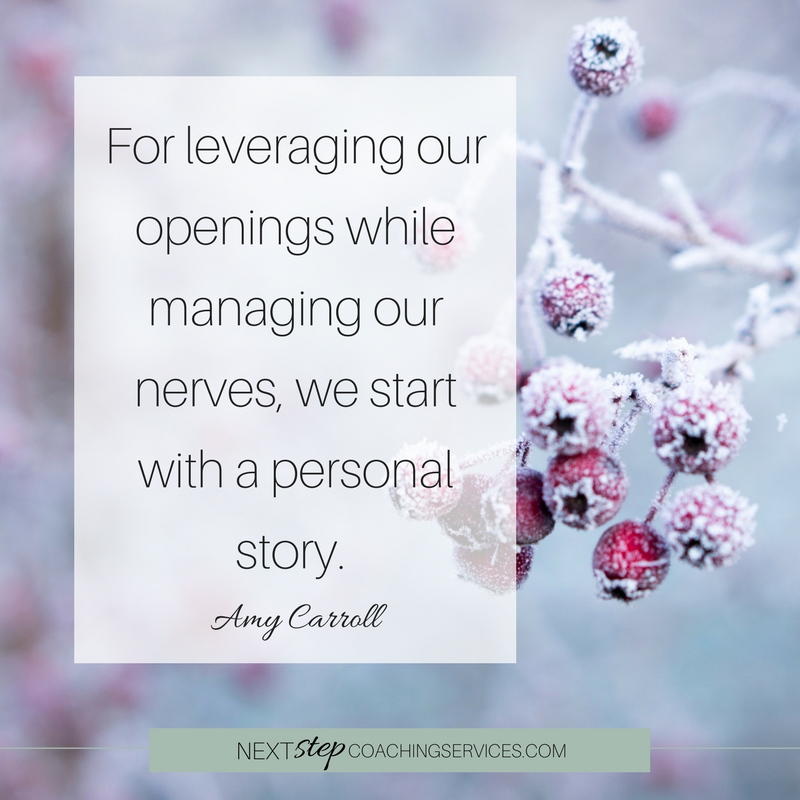Overcoming the Fear Factor in Speaking– Using Story
This page contains affiliate links. Your clicks and purchases help defray Next Step’s website costs at no extra charge to you. Thank you!
One reason that we speakers have to learn to overcome our fear is that experts agree that speakers have less than a minute to capture the attention of their audience. Some say it’s only 15 seconds! When we waste the beginning of our messages fidgeting, apologizing or bumbling around, we lose our audience from the start.
That sounds like a lot of pressure, but I want to share an easy tip today that kills two birds with one stone. For leveraging our openings while managing our nerves, we start with a personal story.
Using powerful stories in our messages has lots of benefits. One of my favorite books that teaches communicators how to harness the power of a story is Made to Stick. I highly recommend this book to all speakers and writers! Stories connect with our audience’s emotions, create “memory hooks” and are truly sticky.
But a personal story at the beginning of our message helps us as speakers too. It gives us confidence since it’s something we know well. It releases us from our notes so that we can establish eye-contact with our audience, and it allows us to paint a picture of ourselves without telling a list of details. Through a personal story the audience can connect with us immediately on an intimate level. All good things!
To tell a story that opens an audience’s heart to us, here are some elements to include:
- A captivating first sentence— I’m a huge believer in standing and starting. You can watch a short video about this by clicking here. Writers are always told to start with a hook. I believe speakers should do the same, so write a captivating first sentence to your story and memorize it. I always craft and memorize three sentences in my messages– the first, the last and my sticky statement. It settles my nerves tremendously to know the first words that will come out of my mouth, and when I follow with a personal story, it gives me time to work out the rest of my nervousness.
- Inner dialogue— Instead of just listing the facts of the event, make sure you’re a true story-teller. As you relate the series of events, let your listeners know what was going through your head and how you were feeling. My crazy thought about a situation is often how I can insert humor into my opening! These are elements that allow your audience to connect deeply, realizing “she’s human too!”
- Carefully curated details— God cares about every detail of our stories, but our audience doesn’t. That sounds harsh, doesn’t it?! But if you’ve ever been in an audience when a speaker was over-sharing, either in the intimacy or number of details, you know exactly what I mean. You might even want to practice telling a story to a friend who will truthfully tell you what can be omitted.
- Purpose— Telling a story at the beginning isn’t like the old-school telling of an unrelated joke at the beginning just to get a laugh. Our stories need to have a purpose, introducing and connecting our topic to the rest of the message. Make sure to choose a story that illustrates your topic.
- Humor— I once heard Kathi Lipp say that people often ask her if you need to be funny to be a speaker. She responds, “No. Only if you want to get hired.” Wow! That gave me a jolt when I heard it because I’m not such a funny speaker. I’ve learned over the years, though, to weave in self-deprecation and my own embarrassing moments to allow my audience to bond with me through laughter. By simply paying attention when people laugh at us (often I’m surprised by a section people find funny!), we can use these “funnies” in other messages.
Opening with a story has multiple benefits, but the most powerful for us as speakers is that it can be used to settle our nerves.
Do you have a great opening story? We’d love to hear about it!

